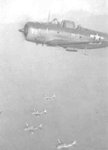Shortround6
Lieutenant General
The idea of the dive brakes was to slow the rate of decent so that more time could be taken to aim or correct aim, that a lower altitude drop could be used ( pulling out at say 240mph/knts instead 350 or more) also increasing accuracy and that at the lower speed the controls were still effective.

